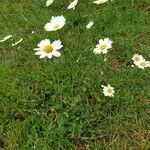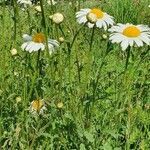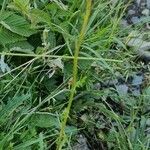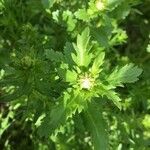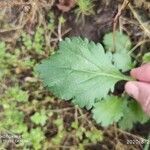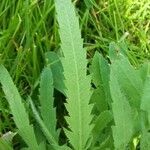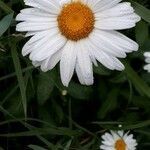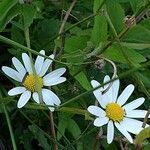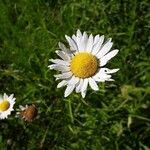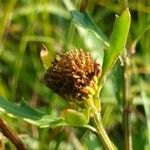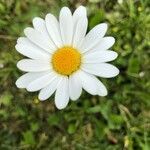Perennial herb to c. 100 cm high, eglandular, with scattered coarse hairs on lower parts of stems and on lower-stem leaves, becoming glabrous. Leaves with few–several lobes or undivided; base developing basal lobes above mid-stem; margin dentate to crenulate, with up to c. 15 teeth/crenulations per side; mid-stem leaves oblanceolate to narrow-oblong, to c. 4 cm long. Capitula 1–3, 3–6 cm diam.; peduncle glabrous; involucre 7–10 mm long, glabrous; outer bracts lanceolate, 2.5–7 mm long, not keeled, with margin brown; inner bracts with hyaline extension c. 1 mm long; mature receptacle convex. Ray floret ligule c. 10–15 mm long, white. Disc florets numerous; corolla 2–2.5 mm long; tube as long as and becoming as wide as limb; limb yellow. Achenes obovoid, c. 1.5–2.5 mm long, mid to dark red between raised pale ribs. Pappus on ray florets a minute corona c. 0.5 mm long.
A daisy plant. It is a herb and has a short rootstock and keeps growing from year to year. It grows 100 cm high and spreads 60 cm wide. It spreads by underground rhizomes. It has few hairs. The leaves at the base have leaf stalks. The leaves are oblong with coarse teeth or divided. They are 2.5-7.5 cm long. The leaves on the stem do not have leaf stalks and clasp the stem. The leaves have coarse teeth. The lower leaves are on slender stalks. The upper leaves clasp the stem. The flowers are daisy like. They are yellow in the centre and white on the outside. The flower heads occur singly at the end of long flower stalks. They are 2.5-5 cm across. The fruit is a dry ribbed achene. The flowers are large and solitary. The flowers grow on long stems to 50 cm high. There is a ring of green sepals underneath the petals.
Perennial herb, 0.3-1.0 m high. Leaves with basal ones in a rosette, roundish to obovate-spathulate, margins crenate to dentate or more deeply lobed, sparsely or nearly glabrous, on long petioles, upper leaves sessile, oblong to narrowly spathulate, decreasing in size upwards, margins toothed to pinnatifid. Capitula radiate, solitary on long, nearly nude stalks. Ray florets female, fertile, white. Disc florets bisexual, fertile, corolla yellow, 5-lobed, tube basally swollen and spongy in fruit, especially abaxially. Flowering time Nov. Pappus of 2 minute scales in ray florets, absent in disc florets. Cypselae narrowly obovate, compressed, ± 10-ribbed.
Perennial herb. Basal leaves in a rosette, roundish to obovate-spathulate, margins crenate to dentate or more deeply lobed, on long petioles. Stem leaves sessile, oblong to narrowly spathulate, margins toothed to pinnatifid. Heads solitary on long, nearly nude stalks. Flowers with white rays, disc yellow.
